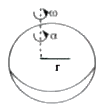A coin moves in a circular path in a rough rotating horizontal surface which has an angular acceleration α
 Solution in Telugu
Solution in Telugu
power delivered by the friction on the coin is positive.
power delivered by centripetal force on the particle is zero.
work done by the contacting frictional force on the system (disc + surface) is negative.
Tangential acceleration of the coin is directly proportional to the rate at which the power is being delivered by the external agent.
The correct Answer is:A, B
Step by step video, text & image solution for A coin moves in a circular path in a rough rotating horizontal surface which has an angular acceleration alpha by Physics experts to help you in doubts & scoring excellent marks in Class 11 exams.
Topper's Solved these Questions
- BOOK - AAKASH SERIESCHAPTER - WORK -POWER-ENERGYEXERCISE - PRACTICE SHEET (EXERCISE-VI POWER) (LEVEL-II MORE THAN ONE CORRECT ANSWER TYPE QUESTIONS)4videos
WORK -POWER-ENERGY
- BOOK - AAKASH SERIESCHAPTER - WORK -POWER-ENERGYEXERCISE - PRACTICE SHEET (EXERCISE-VII VERTICAL CIRCLE AND SPRINGS) (LEVEL -I STRAIGHT OBJECTIVE TYPE QUESTIONS)11videos
WORK -POWER-ENERGY
- BOOK - AAKASH SERIESCHAPTER - WORK -POWER-ENERGYEXERCISE - PRACTICE SHEET (EXERCISE-V MECHANICAL ENERGY AND ITS CONSERVATION) (LEVEL -II INTEGER TYPE QUESTIONS)2videos
WORK -POWER-ENERGY
- BOOK - AAKASH SERIESCHAPTER - VISCOSITY EXERCISE - Questions for Descriptive Answers3videos
VISCOSITY
- BOOK - AAKASH SERIESCHAPTER - WORK POWER ENERGYEXERCISE - EXERCISE - 361videos
WORK POWER ENERGY
Similar Questions
A machine delivers power to body which is proportional to instataneous velocity V of the body. If the body starts with a velocity which is almost negligible, then the distance covered by the body is directly proportional to V. Then find the value of n.
View SolutionA 5 kg is rotated in a vertical circle with a constant speed of 4ms−1 using a sting of length 1m, when the tension in the string is 31N, then the body will be
02:13View SolutionA particle m is projected at an angle with the horizontal with kinetic energy E. The potential energy at the top of its trajector is E/2. The range of the particle is xEmg, then find the value of x is
02:41View SolutionAn iron sphere of mass 20×10−3 kg falls through a viscous liquid with terminal velocity 0.5 m/sec. Find the terminal velocity of another iron sphere of mass 54×10−2 kg.
03:42View SolutionIf →A+→B=→Rand2→A+→B is perpendicular to →B then
02:19View SolutionA particle moving in a circular path has an angular momentum of L. If the frequency of rotation is halved, then its angular momentum becomes
01:16View Solutionवृतीय पथ पर गति करते हुवे किसी पिंड के अभिकेंदर त्वरण का सूत्र कोणीय वेग और वृतीय पथ की त्रिज्या के पदों में लिहिये
02:06View SolutionA particle starting from rest moves with a constant angular acceleration α in a circular path. The time at which the magnitudes of tangential and radial acceleration are equal is -
01:16View SolutionA particle starts moving with a constant angular acceleration in a circular path. The time at which the magnitudes of tangential and radial acceleration are equal is
View SolutionA particle is moving around a circular path with uniform angular speed (x) . The radius of the circular path is (r). The acceleration of the particle is:
View SolutionThe angular acceleration of a particle moving along a circular path with uniform speed is
03:56View SolutionA particle moving in a circular path of certain radius, with uniform angular velocity ω has an angular acceleration equal to :
02:13View SolutionThe angular acceleration of a particle moving along a circular path with uniform speed is
01:44View Solution(A) : When external force acting on a body moving on a rough horizontal surface is doubled, the acceleration of the body is doubled.
(R ) : The acceleration of a body moving on a rough horizontal surface is proportional to the resultant force acting on it.02:43View Solution(A) : When external force acting on a body moving on a rough horizontal surface is doubled, the acceleration of the body is doubled.
(R ) : The acceleration of a body moving on a rough horizontal surface is proportional to the resultant force acting on it.03:04View Solution

